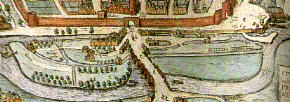
 EXETER
Through the bottom of your
beer glass
Exe Island & Shilhay
Leats and Mills
EXETER
Through the bottom of your
beer glass
Exe Island & Shilhay
Leats and Mills
 Before C9th area this was mud flats, grass and reeds but because this flat piece of land could easily be adapted for
industrial use it attracted the attention of early speculators amongst them Nicholas Gervase.
Before C9th area this was mud flats, grass and reeds but because this flat piece of land could easily be adapted for
industrial use it attracted the attention of early speculators amongst them Nicholas Gervase.
In 1194 he obtained a grant from Robert de Courtney to build a Mill, 'all his water which Thomas the fuller holds of him outside the west gate of Exeter, which is between his corn mills and Crickenpette, so that the said Nicholas and his heirs may build a mill on the said water towards Crickenpette as shall appear best and most commodious to them'.
Anyway the Courtneys capitalized on the potential of this marsh using leats to drain the land and levees to raise it's level to dry it out. The Leats were then used to power 20 to 30 waterwheels for fulling and the griding of corn, making Exe Island Exeter's first Industrial Estate in C12th.There were a series of leats however on these flats from as early as Anglo Saxon times. Evidence for other medieval industries including tanning, the working of horn, bone and bronze came to light during archaeological excavations.
After the Coutenays lands had been confiscated by the King in 1538, (by Henry VIII), Edward VI gave Exe Island to the City in 1550 in recognition of their defence of the City during the Prayer Book Rebellion the previous year.
Cloth-finishing was the most important industry in the C16th.In the late eighteenth century the cloth industry declined and in the C19th the area became occupied by iron foundries, corn mills and breweries.
Higher leat is hived off the river at Head Wear near the Mill On The Exe, and dates from the C12th (but may be Anglo Saxon). There were other leats cutting Exe Island and Shilhay too. Lower Leat is largely covered in but once worked a number of mills. An artificial cut known as Coney Lake dating from late medieval times cut off the river bend from Exe Bridge to the quay area. This and the other leats are shown on Hogenberg's map of 1587 below.
Shilhay forms the downstream end of Exe Island between Exe Bridge and the Quay and was and still is in some respects a flat piece of land just above river level criss-crossed by leats which drained the land and drove water wheels.Bishop Blaze was the patron saint of the wool trade, for which this area of land was primarily used reaching a zenith between 1670 and 1720.
The Bishop was flayed using a Woolcombers rake. The Inn on Shilhay dates from 1327 and was the first to be opened outside the City Walls. It was originally a meeting place for the Tuckers, Weavers and Shearers before Tuckers Hall was built in 1471. The nearby residential scheme incorporates road names such as Teazle, Weavers, Dyers and Carders Court. This area was once covered with cloth drying racks.See also Flooding, Countess Wear Bridges and Exe Crossing